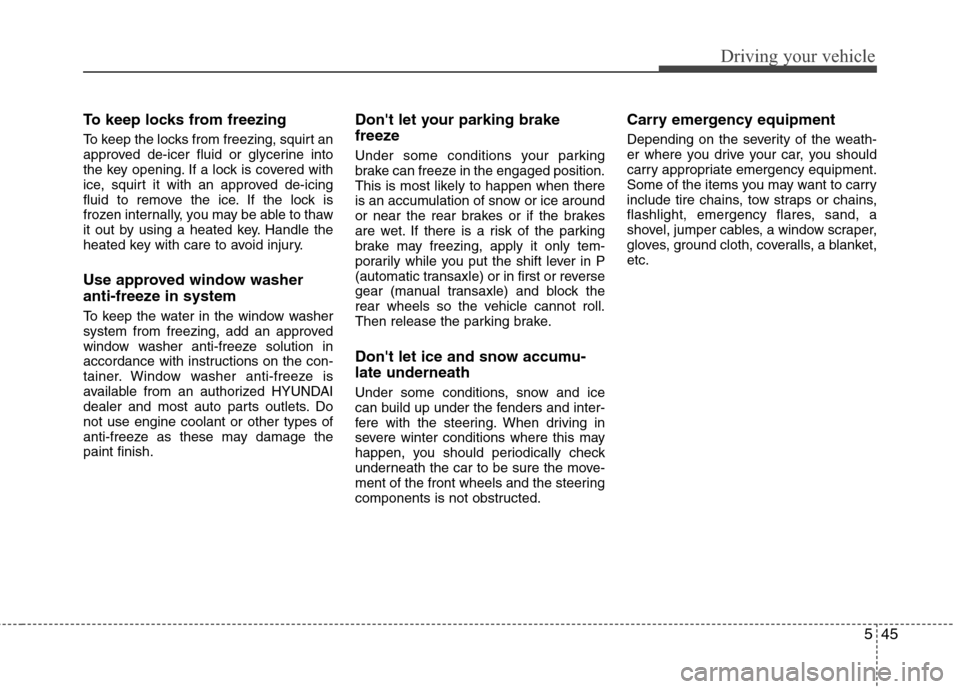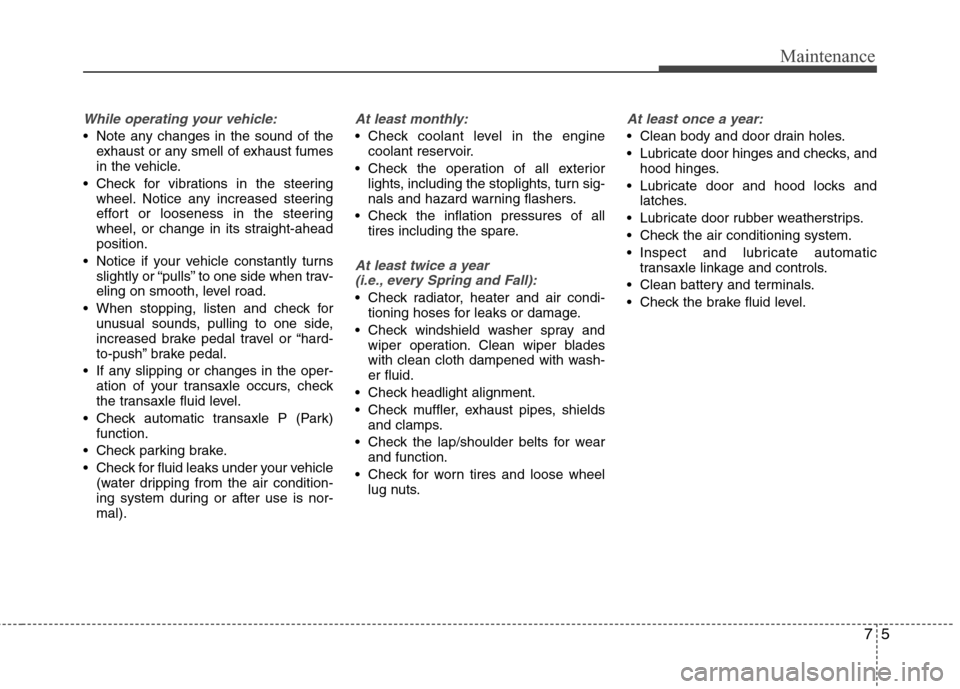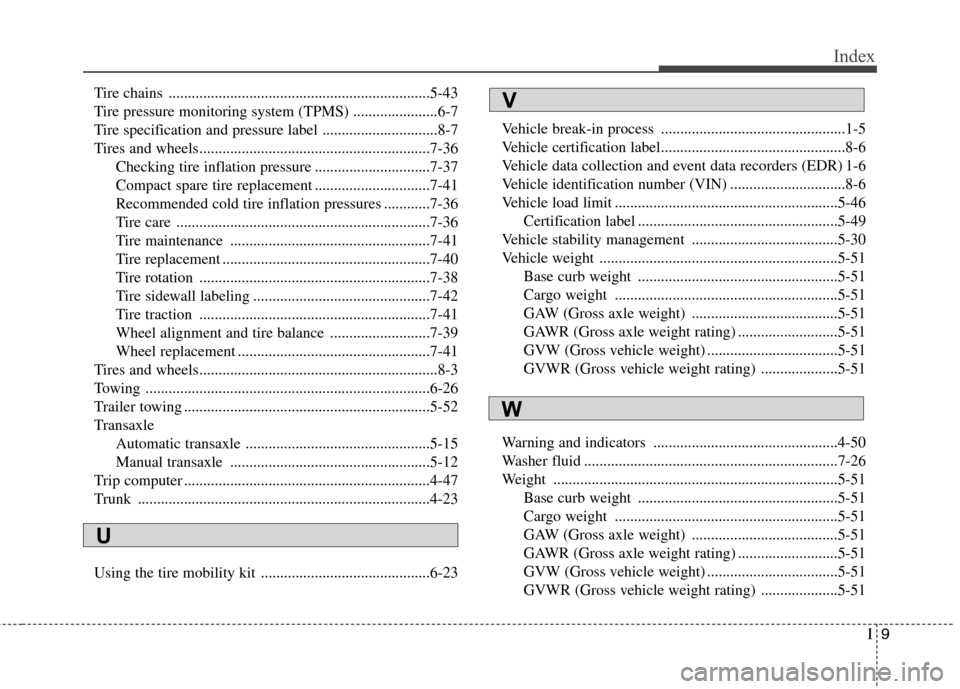axle washer Hyundai Elantra 2013 Owner's Manual
[x] Cancel search | Manufacturer: HYUNDAI, Model Year: 2013, Model line: Elantra, Model: Hyundai Elantra 2013Pages: 383, PDF Size: 8.94 MB
Page 252 of 383

545
Driving your vehicle
To keep locks from freezing
To keep the locks from freezing, squirt an
approved de-icer fluid or glycerine into
the key opening. If a lock is covered with
ice, squirt it with an approved de-icing
fluid to remove the ice. If the lock is
frozen internally, you may be able to thaw
it out by using a heated key. Handle the
heated key with care to avoid injury.
Use approved window washer
anti-freeze in system
To keep the water in the window washer
system from freezing, add an approved
window washer anti-freeze solution in
accordance with instructions on the con-
tainer. Window washer anti-freeze is
available from an authorized HYUNDAI
dealer and most auto parts outlets. Do
not use engine coolant or other types of
anti-freeze as these may damage the
paint finish.
Don't let your parking brake
freeze
Under some conditions your parking
brake can freeze in the engaged position.
This is most likely to happen when there
is an accumulation of snow or ice around
or near the rear brakes or if the brakes
are wet. If there is a risk of the parking
brake may freezing, apply it only tem-
porarily while you put the shift lever in P
(automatic transaxle) or in first or reverse
gear (manual transaxle) and block the
rear wheels so the vehicle cannot roll.
Then release the parking brake.
Don't let ice and snow accumu-
late underneath
Under some conditions, snow and ice
can build up under the fenders and inter-
fere with the steering. When driving in
severe winter conditions where this may
happen, you should periodically check
underneath the car to be sure the move-
ment of the front wheels and the steering
components is not obstructed.
Carry emergency equipment
Depending on the severity of the weath-
er where you drive your car, you should
carry appropriate emergency equipment.
Some of the items you may want to carry
include tire chains, tow straps or chains,
flashlight, emergency flares, sand, a
shovel, jumper cables, a window scraper,
gloves, ground cloth, coveralls, a blanket,
etc.
Page 293 of 383

75
Maintenance
While operating your vehicle:
Note any changes in the sound of the
exhaust or any smell of exhaust fumes
in the vehicle.
Check for vibrations in the steering
wheel. Notice any increased steering
effort or looseness in the steering
wheel, or change in its straight-ahead
position.
Notice if your vehicle constantly turns
slightly or “pulls” to one side when trav-
eling on smooth, level road.
When stopping, listen and check for
unusual sounds, pulling to one side,
increased brake pedal travel or “hard-
to-push” brake pedal.
If any slipping or changes in the oper-
ation of your transaxle occurs, check
the transaxle fluid level.
Check automatic transaxle P (Park)
function.
Check parking brake.
Check for fluid leaks under your vehicle
(water dripping from the air condition-
ing system during or after use is nor-
mal).
At least monthly:
Check coolant level in the engine
coolant reservoir.
Check the operation of all exterior
lights, including the stoplights, turn sig-
nals and hazard warning flashers.
Check the inflation pressures of all
tires including the spare.
At least twice a year
(i.e., every Spring and Fall):
Check radiator, heater and air condi-
tioning hoses for leaks or damage.
Check windshield washer spray and
wiper operation. Clean wiper blades
with clean cloth dampened with wash-
er fluid.
Check headlight alignment.
Check muffler, exhaust pipes, shields
and clamps.
Check the lap/shoulder belts for wear
and function.
Check for worn tires and loose wheel
lug nuts.
At least once a year:
Clean body and door drain holes.
Lubricate door hinges and checks, and
hood hinges.
Lubricate door and hood locks and
latches.
Lubricate door rubber weatherstrips.
Check the air conditioning system.
Inspect and lubricate automatic
transaxle linkage and controls.
Clean battery and terminals.
Check the brake fluid level.
Page 382 of 383

I9
Index
Tire chains ....................................................................5-43
Tire pressure monitoring system (TPMS) ......................6-7
Tire specification and pressure label ..............................8-7
Tires and wheels............................................................7-36
Checking tire inflation pressure ..............................7-37
Compact spare tire replacement ..............................7-41
Recommended cold tire inflation pressures ............7-36
Tire care ..................................................................7-36
Tire maintenance ....................................................7-41
Tire replacement ......................................................7-40
Tire rotation ............................................................7-38
Tire sidewall labeling ..............................................7-42
Tire traction ............................................................7-41
Wheel alignment and tire balance ..........................7-39
Wheel replacement ..................................................7-41
Tires and wheels..............................................................8-3
Towing ..........................................................................6-26
Trailer towing ................................................................5-52
Transaxle
Automatic transaxle ................................................5-15
Manual transaxle ....................................................5-12
Trip computer ................................................................4-47
Trunk ............................................................................4-23
Using the tire mobility kit ............................................6-23Vehicle break-in process ................................................1-5
Vehicle certification label................................................8-6
Vehicle data collection and event data recorders (EDR) 1-6
Vehicle identification number (VIN) ..............................8-6
Vehicle load limit ..........................................................5-46
Certification label ....................................................5-49
Vehicle stability management ......................................5-30
Vehicle weight ..............................................................5-51
Base curb weight ....................................................5-51
Cargo weight ..........................................................5-51
GAW (Gross axle weight) ......................................5-51
GAWR (Gross axle weight rating) ..........................5-51
GVW (Gross vehicle weight) ..................................5-51
GVWR (Gross vehicle weight rating) ....................5-51
Warning and indicators ................................................4-50
Washer fluid ..................................................................7-26
Weight ..........................................................................5-51
Base curb weight ....................................................5-51
Cargo weight ..........................................................5-51
GAW (Gross axle weight) ......................................5-51
GAWR (Gross axle weight rating) ..........................5-51
GVW (Gross vehicle weight) ..................................5-51
GVWR (Gross vehicle weight rating) ....................5-51V
U
W